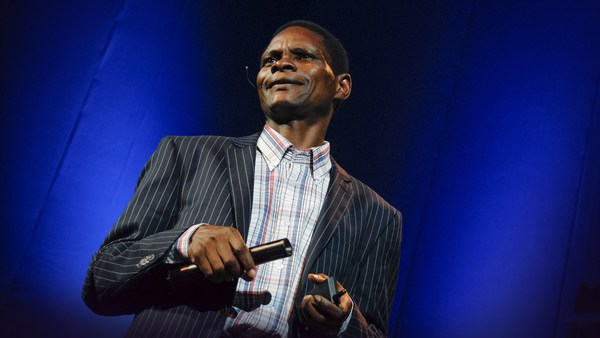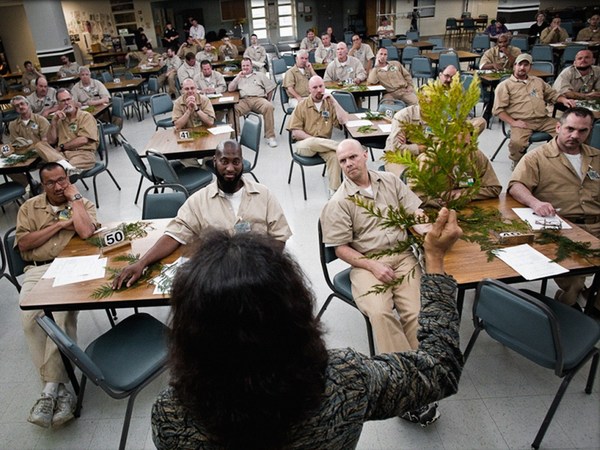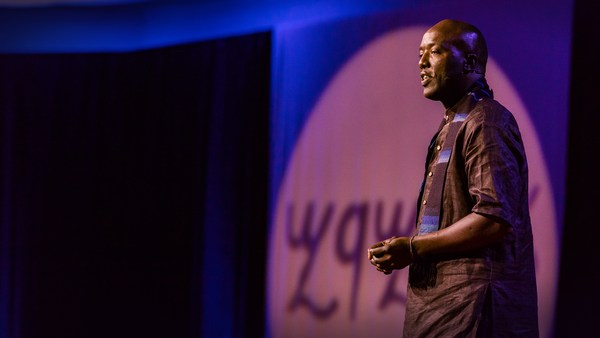Trees epitomize stasis. Trees are rooted in the ground in one place for many human generations, but if we shift our perspective from the trunk to the twigs, trees become very dynamic entities, moving and growing. And I decided to explore this movement by turning trees into artists. I simply tied the end of a paintbrush onto a twig. I waited for the wind to come up and held up a canvas, and that produced art. The piece of art you see on your left is painted by a western red cedar and that on your right by a Douglas fir, and what I learned was that different species have different signatures, like a Picasso versus a Monet.
But I was also interested in the movement of trees and how this art might let me capture that and quantify it, so to measure the distance that a single vine maple tree -- which produced this painting -- moved in a single year, I simply measured and summed each of those lines. I multiplied them by the number of twigs per branch and the number of branches per tree and then divided that by the number of minutes per year. And so I was able to calculate how far a single tree moved in a single year. You might have a guess. The answer is actually 186,540 miles, or seven times around the globe. And so simply by shifting our perspective from a single trunk to the many dynamic twigs, we are able to see that trees are not simply static entities, but rather extremely dynamic.
And I began to think about ways that we might consider this lesson of trees, to consider other entities that are also static and stuck, but which cry for change and dynamicism, and one of those entities is our prisons. Prisons, of course, are where people who break our laws are stuck, confined behind bars. And our prison system itself is stuck. The United States has over 2.3 million incarcerated men and women. That number is rising. Of the 100 incarcerated people that are released, 60 will return to prison. Funds for education, for training and for rehabilitation are declining, so this despairing cycle of incarceration continues. I decided to ask whether the lesson I had learned from trees as artists could be applied to a static institution such as our prisons, and I think the answer is yes.
In the year 2007, I started a partnership with the Washington State Department of Corrections. Working with four prisons, we began bringing science and scientists, sustainability and conservation projects to four state prisons. We give science lectures, and the men here are choosing to come to our science lectures instead of watching television or weightlifting. That, I think, is movement. We partnered with the Nature Conservancy for inmates at Stafford Creek Correctional Center to grow endangered prairie plants for restoration of relic prairie areas in Washington state. That, I think, is movement. We worked with the Washington State Department of Fish and Wildlife to grow endangered frogs -- the Oregon spotted frog -- for later release into protected wetlands. That, I think, is movement.
And just recently, we've begun to work with those men who are segregated in what we call Supermax facilities. They've incurred violent infractions by becoming violent with guards and with other prisoners. They're kept in bare cells like this for 23 hours a day. When they have meetings with their review boards or mental health professionals, they're placed in immobile booths like this. For one hour a day they're brought to these bleak and bland exercise yards. Although we can't bring trees and prairie plants and frogs into these environments, we are bringing images of nature into these exercise yards, putting them on the walls, so at least they get contact with visual images of nature. This is Mr. Lopez, who has been in solitary confinement for 18 months, and he's providing input on the types of images that he believes would make him and his fellow inmates more serene, more calm, less apt to violence.
And so what we see, I think, is that small, collective movements of change can perhaps move an entity such as our own prison system in a direction of hope. We know that trees are static entities when we look at their trunks. But if trees can create art, if they can encircle the globe seven times in one year, if prisoners can grow plants and raise frogs, then perhaps there are other static entities that we hold inside ourselves, like grief, like addictions, like racism, that can also change.
Thank you very much.
(Applause)





